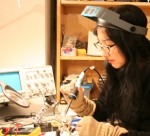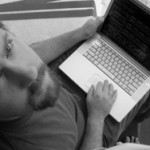The process of creating and developing the complex hardware design required for LED KIMONO has been possible with the collaborative input of experts in innovative electrical engineering and software programming such as Bob Bielecki and Damon Holzborn. Conference calls, meetings testing of ideas, have characterized the early stages of designing the LED KIMONO leading to multiple and constantly changing stages of “proof of concept”. The “schematic” or scheme has been known to change from hour to hour, with different designers making changes, corrections, and overhauls to the plan. For practicality, sleeves, front panels, collars, are each a prototype that has been patchworked together.
Miya Masaoka
 Concept, lead artist and designer. Ms. Masaoka is a composer, performer and developer of interactiveinterfaces for Pieces for Plants (bio feedback response for Philodendrom), Laser Koto (sensors for triggering and gestural response), Ritual for Giant Hissing Madagascar Cockroaches, The Sound of Naked Men (EKG, EEG feedback), Thinking Sounds (Brain biofeedback compositions) and Plants Derail Model Train (explosive powders and plant feedback) and many other works.
Concept, lead artist and designer. Ms. Masaoka is a composer, performer and developer of interactiveinterfaces for Pieces for Plants (bio feedback response for Philodendrom), Laser Koto (sensors for triggering and gestural response), Ritual for Giant Hissing Madagascar Cockroaches, The Sound of Naked Men (EKG, EEG feedback), Thinking Sounds (Brain biofeedback compositions) and Plants Derail Model Train (explosive powders and plant feedback) and many other works.
Miya Masaoka (musician, composer, sound installation artist) has a body of work that includes employing and developing the use of interfaces for more than twenty years for achieving new compositions, performances and sound installations. Pieces for Plants, a series of compositions based on the real time responsive behavior of plants, was performed at IRCAM (NIME 2007), and at Lincoln Center for the Arts (Homemade Instrument Day), and exhibited at the Baltimore Center for Visual Culture. Her piece for multi-channel sound, Inner Koto, was commissioned by Engine 27, and was exhibited at the Kitchen (group show, Morrow Cube) and at the Winter Olympics in Torino, Italy.
Her work with brain wave activity and mapping of various wave activity to sound parameters was made tangible in Naked Sounds for the new music ensemble “sfsound.” Here, wave forms were interpreted by superimposing visual brain waves onto the grand staff of music notation as the basis for the score. The score was recently included in the exhibit “Between Thought and Sound: New Notation in Contemporary Music.”
An early work, Ritual: for Giant Madagascar Cockroaches used an array of sensors and lasers and cockroaches whose movements triggered samples and generated the sound for the piece. This piece was performed in many countries, includingV2 in Rotterdam, and Le Centrale in Montreal, Canada. Ms. Masaoka has had numerous residencies at STEIM, in Amsterdam, developing expressive interfaces for the koto, and she has developed a body of work on the processing of sounds, samples and input interactive response. The Laser Koto (variant of laser harp) is an array of four horizontal lasers with koto sounds that are activated by the use of on/off and continuous controller sensors and physical gestures. She has also created a piece using explosive powder, and plant activity to make small explosions, emulating the experiments of the 1950’s of derailing model trains with plant activity and ESP. (Plant Derails Model Train, premiered at Issue Project Room, 2007). The LED KIMONO has recently been supported by a Harvest Works Residency, and will have a performance at the San Francisco Electronic Music Festival in 2009. For more information on Miya Masaoka, go to www.miyamasaoka.com.
Bob Bielecki
Lead engineer; hardware and software: specializing in the creative use of technology in the electronic arts; additional expertise as audio engineer, exhibition designer, electrical engineer, software developer, and artist/collaborator. Collaborated since the mid-1970s with Laurie Anderson and La Monte Young on work including creation of unique instruments and interfaces used in performance installations. Current work in sound localization and imaging.
Grants from Andy Warhol Foundation and New York State Council on the Arts. Faculty, Co Chair of the Milton Avery Graduate School of the Arts. (1997”“ ) Visiting Assistant Professor of Music.
Damon Holzborn
 Software programmer, design and development: Holzbornis an improviser and composer, who works primarily with electronics. In performance, he makes the recognizable unrecognizable, subjecting sound sources such as guitar and field recordings to manipulation through custom-programmed interfaces, traditional effects and interactive processes. He is a founding member of the Trummerflora collective and co-creator of zucasa.com, recently named one of the top 25 essential online music resources by The Wire. Holzborn holds a degree in music from UCSD, where he studied improvisation with George Lewis, guitar with Celin Romero, and composition with Frederic Rzewski, Brian Ferneyhough, Will Ogden and Rand Steiger.
Software programmer, design and development: Holzbornis an improviser and composer, who works primarily with electronics. In performance, he makes the recognizable unrecognizable, subjecting sound sources such as guitar and field recordings to manipulation through custom-programmed interfaces, traditional effects and interactive processes. He is a founding member of the Trummerflora collective and co-creator of zucasa.com, recently named one of the top 25 essential online music resources by The Wire. Holzborn holds a degree in music from UCSD, where he studied improvisation with George Lewis, guitar with Celin Romero, and composition with Frederic Rzewski, Brian Ferneyhough, Will Ogden and Rand Steiger.
Holzborn has presented his work in the US, Mexico and Japan, performing as a solo artist and with several ensembles, including Donkey (a decade-long collaboration with musician/filmmaker Hans Fjellestad), Quibble, and Titicacaman (with Nathan Hubbard and Marcelo Radulovich). He has performed and/or recorded with Muhal Richard Abrams, George Lewis, Lê Quan Ninh, Eugene Chadbourne, Matt Ingalls, Andrea Polli, DJ Marcus B, Scott Looney, Jason Robinson, Anthony Burr, Marcos Fernandes, Marcelo Radulovich, Scott Walton, Mike Keneally, Ellen Weller, Kristy Cheadle, Alan Lechusza, Nathan Hubbard, Robert Montoya, Joscha Oetz, Mike Khoury, Blaise Siwula, Nortec Collective, Jonathan Glasier and The San Diego Art Ensemble. Holzborn also regularly creates music for dance, often collaborating with innovative dance collective Lower Left, producing both custom compositions and improvised performances. For more information on Damon Holzborn, go to www.damonholzborn.com
Jeff Snyder
Schematics, consultant
Consultants
ERIC SINGER, Adam
Support from NEA, HarvestWorks Residency Program, Circuit Network and thanks to NYC Resistor Collective, IRCAM, San Francisco Electronic Music Festival, Michael Shumacher and Diapason.